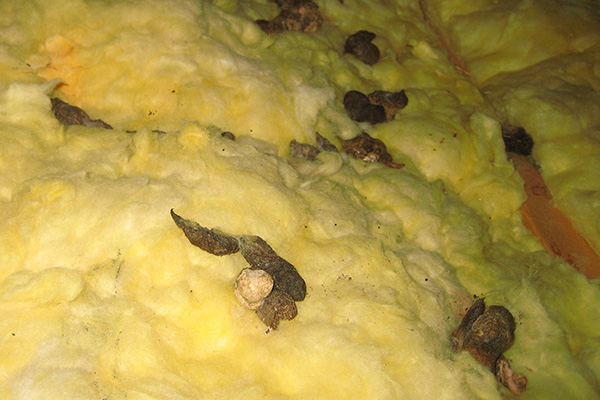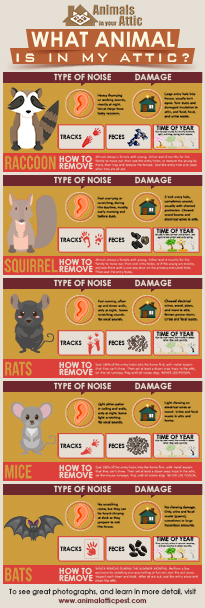- info@animalatticpest.com
- Call - we service 300 locations

How To Tell What Kind of Animal is in my Attic
The first indicator of an animal problem in the attic is the noise. You may hear scratching or thumping, or scittering or nuts rolling around or even vocal noises. But you still don't know what type of animal or animals are up there! It's very helpful to know what type of critters are living in your attic, because the approach to solving the problem varies greatly depending on the type of animal. Removing raccoons is a very different strategy than removing rats! Let's examine the various clues. First up is the noise. If the sounds are in the daytime, especially early morning or evening, you have squirrels in your house. If the noise is at night but very heavy sounding, and slow, it's likely raccoons. Opossums are another option, but they are rarer. Raccoons are also most likely to make vocal noises. If the noise is a fast pitter-patter at night, especially if there's any noise going up and down the walls, then it's likely rats or mice, though it could be flying squirrels. If you hear fluttering and chirping, it could be bats or birds. Read more about the types of animal noises in the attic.
How To Tell What Kind of Animal is in My Attic
Clue #1 - The Type of Noise
Is the noise from a large animal or a small animal? Does it happen during daylight hours (probably squirrel) or is it mostly at night? In the walls? That's likely rats or mice.
Clue #2 - The Type of Entry Hole
A big torn-out hole is likely a raccoon. A 2-inch hole with chewing around the perimeter is likely a squirrel. Brown grease is from rats, and bats leave droppings at the hole.
Clue #3 - The Type of Feces
This website has many photos of the feces of each type of common attic animal. Get in the attic and examine the feces in the insulation, and compare it to the photos.
Information About How To Tell What Kind of Animal is in My Attic
Second clue is the entry hole. Examine the outside of the house, especially around the eves, vents and roof, and you'll find the entry holes. If it's a
large hole with damage, like a torn open roof or a busted eave, that's a raccoon!
If it's a hole maybe 2 inches in diameter with chewing around the perimeter, that's squirrel. If it's small gaps, perhaps with brown grease, that's rats or mice. Read more about inspecting the house for animal holes to
determine the sort of wildlife entering the building. There might be other clues on your house or at the entry hole, such as footprints,
hair, and so on.
Third, the inspection in the attic is the real clincher. There you will find various evidence, most importantly, you can identify the feces. If you know how to identify these, you will know your culprit. This
website has many photos of all the different animal feces. Look at photos of Raccoon Feces, or Squirrel Feces, or Rat Feces, or
Mouse Feces, or Bat Feces.
You can also look at the animal tracks left in the dust in the attic. Check on almost any surface not covered by insulation, and there should be a layer of dust with animal tracks. Or you can check for muddy footprints. Raccoons
are notorious for this. Rats and mice leave brown grease marks in areas of heavy travel too. The infographic to the left shows what various animal tracks look like. Though truth be told, it's probably rare that an amateur will find and identify
tracks correctly.
Finally, you can look at the animal damage such as chewing. If you see small
chewmarks on wires, that's the work of a rodent. But a duct completely torn up is the work of a raccoon. Large amounts of plant debris in one spot is usually from squirrels. Click here for photos of animal damage in the attic to help
you identify what critters you have up there. If you have experience like
me, you will actually know right away by the odor in the attic! Each animal has a trademark scent.
Of course, you can also watch your house outside, especially if you know the entry hole and time of activity, and catch the animal in the act. Rarely will you actually
see the animals in the attic. It happens for me less than 5% of the time. Most of the time the animals will crawl down a dark wall or under insulation, or in the shadows, and stay super still. But when you read the signs,
it's easy to identify what animals you have.
Share this Image On Your Site
Also, don't forget the time of year. Different animals are more likely to enter your home during different times of the year. Raccoons can enter year-round, but 90% of cases happen in the months of March, April, and May, when the female raccoons enter attics looking for a safe place to give birth. Female squirrels give birth twice per year, in late summer and late winter, and you might hear her then, but many people don't notice the noise until 6 weeks later, when the young squirrels start running around (at which point you hear 5 animals instead of 1) and that's usually September/October or February/March. Rats and mice can also enter year-round, but they are far more likely to go into a building for warmth during the cold winter months. Bats are the opposite. They either migrate away for the winter, or sleep (torpor, like hibernation), and are only active during the summer.
The Bottom Line
Look at the clues! Though noise and damage and footprints are good, the best is to look at the feces. Once you know the type of animal making noise in your attic or ceiling or anywhere else in your house, you can follow the correct strategy for removing that animal type.





